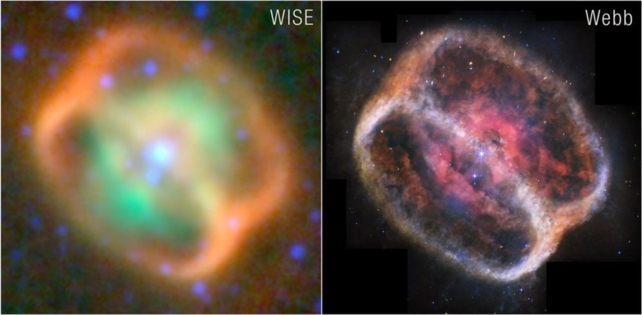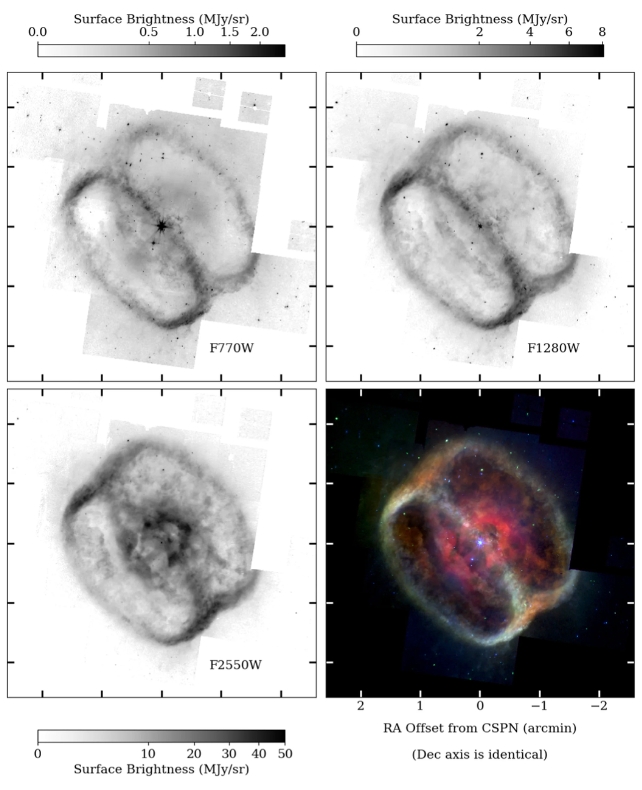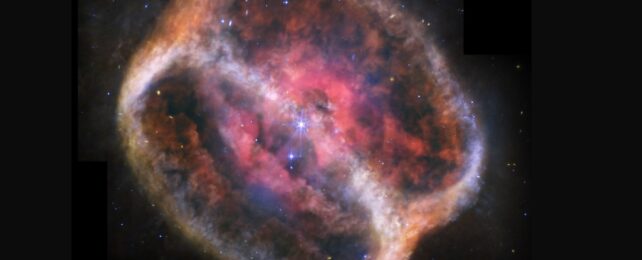NGC 1514 is a planetary nebula about 1500 light-years away. William Herschel discovered it in 1790, and its discovery made him rethink the nature of nebulae.
It's been imaged many times by modern telescopes, and each time a more capable one revisits it, astronomers learn more about it. The JWST is the latest to observe the curious nebula, and its observations help explain the unusual object.
In 1790, NGC 1514 looked different from other patches of nebulosity in the sky. Prior to detecting it, Herschel thought that nebulae were masses of stars that couldn't be resolved. But this one was different: he wrote that it was a lone star "surrounded with a faintly luminous atmosphere."
Fast forward to modern times, and NASA's WISE (Wide-field Infrared Survey Explorer) found a pair of rings around the nebula that are only visible in infrared.
In new research, astronomers used the powerful JWST to get a better look at NGC 1514.
Their results are in a paper titled "JWST/MIRI Study of the Enigmatic Mid-infrared Rings in the Planetary Nebula NGC 1514," published in The Astronomical Journal. Michael Ressler, a researcher and project scientist for Webb's MIRI (Mid-Infrared Instrument) at NASA's Jet Propulsion Laboratory, is the lead author.
"While NGC 1514 is an elliptical but complex planetary nebula at optical wavelengths, it was discovered to have a pair of infrared-bright, axisymmetric rings contained within its faint outer shell during the course of the Wide-field Infrared Survey Explorer all-sky survey," the authors write in their paper."
The astronomers collected the observations using the JWST's MIRI Imager and Medium Resolution Spectrometer and its set of filters.
"These observations show that the rings are clearly resolved and relatively distinct structures, with both filamentary and clumpy detail throughout," the researchers explain.

A pair of binary stars reside in the center of NGC 1514. They appear as a single purple star with bright diffraction spikes in the image.
The nebula's double-ringed appearance was generated by one of the stars as it aged. The star was originally several times more massive than the Sun, and as it evolved into a red giant, it cast off its outer layers of gas, which formed the nebula.
"As it evolved, it puffed up, throwing off layers of gas and dust in a very slow, dense stellar wind," said David Jones, a senior scientist at the Institute of Astrophysics on the Canary Islands, who proved there is a binary star system at the center in 2017.
That star is now a white dwarf, and its companion is now a giant star on the horizontal branch.
Astronomers knew all of this before they observed NGC 1514 with the JWST. However, the JWST allowed them to understand the nebula's turbulent nature over the past 4,000 years.
"Before Webb, we weren't able to detect most of this material, let alone observe it so clearly," said lead author Ressler in a press release.
He discovered the rings around NGC 1514 in 2010 when he examined the image from NASA's Wide-field Infrared Survey Explorer (WISE). "With MIRI's data, we can now comprehensively examine the turbulent nature of this nebula," Ressler said.

While from our viewing angle, NGC 1514 looks like a can being poured out, it actually has the shape of an hourglass. There are hints of a pinched waist near the top left and bottom right, and at these locations, the dust is orange and drifts into shallow V-shapes.
"When this star was at its peak of losing material, the companion could have gotten very, very close," Jones said. "That interaction can lead to shapes that you wouldn't expect. Instead of producing a sphere, this interaction might have formed these rings."
The new JWST observations resolve the pair of rings clearly and also show the clumps and filaments in more detail. Inside the rings is cloud-like material that appears turbulent, while just outside of the ring boundaries, there are faint, ejecta-like structures.
The JWST allowed the researchers to dig more deeply into the nebula's composition.
The rings are bright, but instead of being line emissions from things like atomic hydrogen, polycyclic aromatic hydrocarbons (PAHs), or shocked molecular hydrogen, the brightness comes from thermal emission from dust grains.
The researchers explain that only about 1.5% of the ring flux comes from line emissions. This is unusual since carbon and PAHs are common in planetary nebulae.

That means that, unlike some other nebulae, the ring structures are not made of material that has been shocked by slamming into the ISM. If they were, there would be more emissions from molecular hydrogen.
The lack of emissions from PAHs or any other molecules backs that up. "…we conclude that essentially none of the flux from the rings seen in the MIRI images comes from line emission," they write. Instead, it's dominated by dust emission.
Ressler and his co-researchers explain that NGC 1514 is shaped mostly by strong winds coming from the main star. These winds are asymmetrical, probably due to interactions between the pair of stars in the centre. However, the detail of how the rings were created eludes them for now.
"Unfortunately, our observational results, taken by themselves, do not offer any direct insight into the formation of the rings; we have said something about what they are but cannot say how they got there," they write.
Research into other nebulae could provide an answer, however. It's possible that a strong thermal pulse from the binary stars' common envelope created pronounced changes in density in the material that the nebula is expanding into.
It's possible that "… a period of heavy mass loss formed the dense regions that would become the source material for the rings, followed by fast jets/winds that carved out the material along the poles to yield a more ring-like structure," the authors explain in their paper. Unfortunately, the observations can't confirm this scenario.
"Regardless, the new data do complete the picture of the rings being cool dusty structures embedded in the tenuous outer shell of a very complex but fascinating planetary nebula," they conclude.
This article was originally published by Universe Today. Read the original article.
